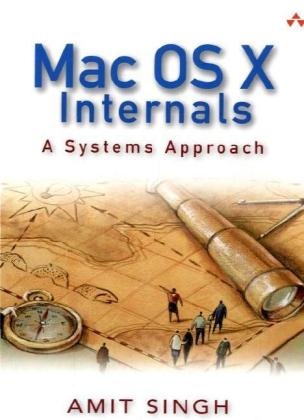Description
Preface xxv Acknowledgments xxxi About the Author xxxiii Chapter 1 Origins of Mac OS X 1 1.1 Apple's Quest for the Operating System 2 1.2 The NeXT Chapter 9 1.3 The Mach Factor 15 1.4 Strategies 24 1.5 Toward Mac OS X 31 Chapter 2 An Overview of Mac OS X 43 2.1 Firmware 46 2.2 Bootloader 46 2.3 Darwin 46 2.4 The xnu Kernel 48 2.5 A User-Space View of the File System 57 2.6 The Runtime Architecture 61 2.7 The C Library 74 2.8 Bundles and Frameworks 76 2.9 Core Services 89 2.10 Application Services 90 2.11 Application Environments 101 2.12 User Interface 117 2.13 Programming 121 2.14 Security 131 2.15 Mac OS X Server 145 2.16 Networking 153 Chapter 3 Inside an Apple 155 3.1 The Power Mac G5 156 3.2 The G5: Lineage and Roadmap 166 3.3 The PowerPC 970FX 174 3.4 Software Conventions 224 3.5 Examples 240 Chapter 4 The Firmware and the Bootloader 263 4.1 Introduction 263 4.2 A Whole New World 266 4.3 Power-On Reset 271 4.4 Open Firmware 272 4.5 Forth 279 4.6 The Device Tree 289 4.7 Open Firmware Interfaces 298 4.8 Programming Examples 300 4.9 Firmware Boot Sequence 324 4.10 BootX 328 4.11 Alternate Booting Scenarios 340 4.12 Firmware Security 349 4.13 Launching the Kernel 352 4.14 The BootCache Optimization 353 4.15 The Boot-Time Kernel Arguments 355 4.16 The Extensible Firmware Interface 362 Chapter 5 Kernel and User-Level Startup 381 5.1 Arranging for the Kernel to Execute 382 5.2 Low-Level Processor Initialization 388 5.3 High-Level Processor Initialization 405 5.4 Mach Subsystem Initialization 421 5.5 The First Thread 432 5.6 I/O Kit Initialization 435 5.7 BSD Initialization 443 5.8 Launching the First User-Space Program 469 5.9 Slave Processors 470 5.10 User-Level Startup 472 Chapter 6 The xnu Kernel 501 6.1 xnu Source 501 6.2 Mach 510 6.3 A Flavor of the Mach APIs 519 6.4 Entering the Kernel 529 6.5 Exception Processing 543 6.6 System Call Processing 553 6.7 System Call Categories 557 6.8 Kernel Support for Debugging, Diagnostics, and Tracing 601 6.9 Virtual Machine Monitor 659 6.10 Compiling the Kernel 676 Chapter 7 Processes 683 7.1 Processes: From Early UNIC to Mac OS X 684 7.2 Mach Abstractions, Data Structures, and APIs 687 7.3 Many Threads of a New System 726 7.4 Scheduling 774 7.5 The execve() System Call 812 7.6 Launching Applications 828 Chapter 8 Memory 835 8.1 Looking Back 835 8.2 An Overview of Mac OS X Memory Management 838 8.3 Mac VM 846 8.4 Resident Memory 868 8.5 Virtual Memory Initialization during Bootstrap 877 8.6 The Mach VM User-Space Interface 878 8.7 Using the Mach VM Interfaces 893 8.8 Kernel and User Address Space Layouts 907 8.9 Universal Page Lists (UPLs) 912 8.10 Unified Buffer Cache (UBC) 913 8.11 The Dynamic Pager Program 918 8.12 The Update Daemon 921 8.13 System Shared Memory 922 8.14 Task Working Set Detection and Maintenance 942 8.15 Memory Allocation in User Space 948 8.16 Memory Allocation in the Kernel 980 8.17 Memory-Mapped Files 1001 8.18 64-bit Computing 1005 Chapter 9 Interprocess Communication 1021 9.1 Introduction 1021 9.2 Mach IPC: An Overview 1025 9.3 Mach IPC: The Mac OS X Implementation 1041 9.4 Name and Bootstrap Servers 1060 9.5 Using Mach IPC 1080 9.6 MIG 1094 9.7 Mach Exceptions 1112 9.8 Signals 1129 9.9 Pipes 1145 9.10 Named Pipes (Fifos) 1147 9.11 File Descriptor Passing 1148...
Product details
| Authors | Amit Singh |
| Publisher | Addison-Wesley |
| Languages | English |
| Product format | Paperback / Softback |
| Released | 15.09.2006 |
| EAN | 9780321278548 |
| ISBN | 978-0-321-27854-8 |
| Dimensions | 183 mm x 240 mm x 62 mm |
| Subject |
Education and learning
|
Customer reviews
No reviews have been written for this item yet. Write the first review and be helpful to other users when they decide on a purchase.
Write a review
Thumbs up or thumbs down? Write your own review.

